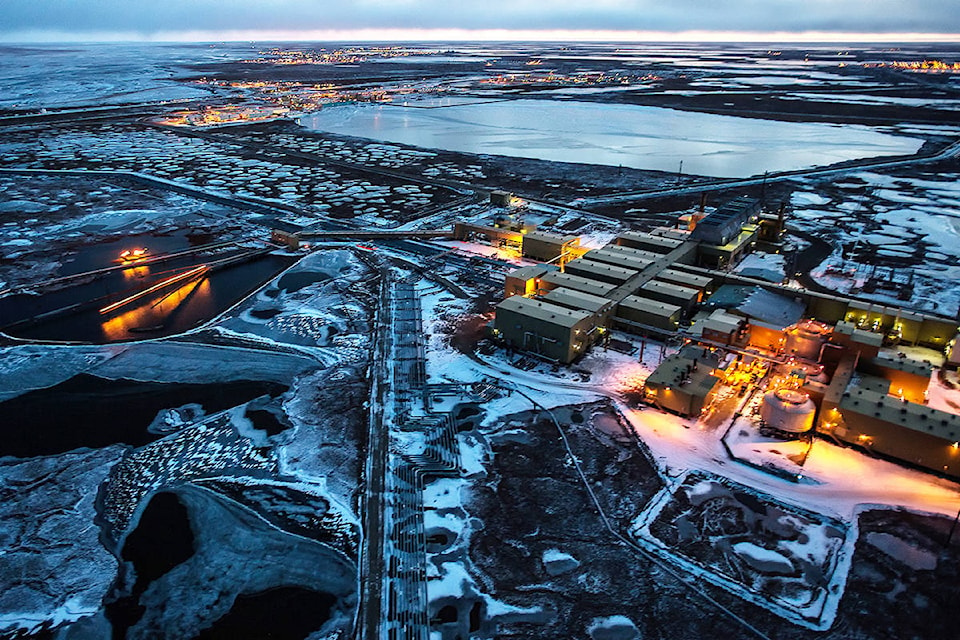Caribou calf survival rates for the Porcupine caribou herd could fall as much as 8.2 per cent if all of 1002 Area within the Arctic National Wildlife Refuge (ANWR) were to be opened up to oil and gas exploration and drilling, says an Alaskan biologist.
1002 Area contains the Porcupine caribou herd’s calving grounds, as well as an estimated 10.2 billion barrels of oil. Currently, the area is protected against exploration but recent moves by Republicans in the U.S. Senate are attempting to open the area up for drilling.
The Gwich’in on both sides of the border rely on the Porcupine caribou and consider the calving grounds sacred.
Brad Griffith, unit leader with the Alaska Cooperative Fish and Wildlife Research Unit and one of the lead researchers on a long-term study of the Porcupine herd, said that this predicted drop could cause an overall decline in the population. The herd — which is currently considered healthy with an estimated 200,000 animals — can sustain a 4.6 per cent reduction in calf survival rates before the overall population is threatened, he said.
“The simulations indicated that a substantial reduction in calf survival during June would be expected under full development of the 1002 Area,” the study reads.
“To put it in perspective, would you want your (retirement fund) to decline by 8.2 per cent every year?” Griffith said.
Griffith said the data set used in this study only goes to 2001, and that more data has been collected since then which would likely lower the predicted drop in calf survival. This is because, for a time, the herd chose to winter on the Canadian side of the border, away from its preferred calving grounds on the U.S. side. Why the caribou did this is unknown, although it has happened before. The herd has since switched back to the 1002 Area calving grounds.
“If we could redo the analysis right now, in 2017, and included the data set post 2001, it’s more than likely the impact on calf survival could be reduced … but I’m not convinced at all that it would be less than what would be required to effect the population,” he said. “I wouldn’t be surprised if it was still above 4.6 per cent, if all else held equal.”
This projected reduction in calf survival would be the result of a domino effect caused by disturbing the habitat by building the roads and infrastructure required for oil extraction, Griffith said.
This is significant because of the geography of the landscape the Porcupine herd occupies. The herd is bounded by the sea and mountains. The only other place they could go would be into the foothills, where the predators are, resulting in a reduction in the quality of available food, which increases losses to predators, he said.
“Calf survival is a function of food and predation risk,” he said.
Griffith’s study notes that it is “remotely conceivable” that the herd could find alternative habitats “that yielded equivalent forage and predation risk after displacement,” but this is “quite unlikely” based on the available data. A reduction in forage quality and a greater threat from predators means that pregnant and nursing caribou cows have a harder time getting the calories they need to produce healthy calves and stay healthy.
Proponents of oil development in 1002 Area often point to the Porcupine herd’s neighbour, the Central Arctic herd, as an example of a caribou thriving in close proximity to oil development. In 1977, drilling began in the Prudhoe Bay oil field, an area in which the Central Arctic herd wintered and calved. Prudhoe Bay is the largest oil field in North America and currently produces 281,000 barrels of oil per day. The Central Arctic herd has remains healthy despite this high-intensity production.
Beth Lenart, a biologist for the Alaska Department of Fish and Game, said the comparison between the two herds isn’t a fair one. The Central Arctic herd simply have more habitat choices thanks to geography than the Porcupine herd, which is channelled into a much narrower area, she said.
The two herds, while comprised of the same species of animals, act differently and are vulnerable to different threats, she said.
“The (Central Arctic) caribou have adapted to the infrastructure (in Prudhoe Bay) but cow caribou are disturbed by infrastructure and roads,” she said. “There was still quite a bit of habitat available…. That’s what has worked for the Central Arctic herd.”
The Central Arctic herd is also smaller and hunted less by humans, thanks in part to its remoteness, Lenart said.
But the Central Arctic herd’s numbers are still dropping for reasons that aren’t fully understood. In 2010, the population of the herd was estimated at approximately 68,000. By 2013, that number had dropped to 50,000 and in 2016, plummeted to just 22,000 animals.
While caribou herds do go through “natural oscillations, that is still a really sharp, steep decline,” Lenart said. Still, she added, it’s hard to pin the decline on industrial activity.
“It’s incredibly hard to study caribou,” said Lenart. “You think you’ve figured them out, that you’ve got them mapped out — and then they surprise you and do something different.”
In 1988, the Porcupine herd underwent one of these natural declines, Griffith said. Caribou migrate over vast distances, and so issues at one end of their migration can be compounded by problems elsewhere along the route.
“A small effect (in) one place, they can find something adequate to replace that,” Griffith said. “But what’s really important for caribou is that they can move freely across the landscape.”
“The facts are, if 1002 Area is developed it’s more than likely going to (mean) a reduction in calf survival, which interacts with every other thing that impacts the sustainability of the herd.”
Contact Lori Fox at lori.fox@yukon-news.com
